|
-
19th July 09, 07:30 PM
#11
 Originally Posted by Ted Crocker

Don't know if it matters, but I've often used a knife that has been sharpened in a certain way to cut tight stitches. It's sharpend without removing all the tiny, tiny serarations made by the stone, and it almost saws through the stiche. So I stick the point between the stitches, pull the seam apart a little, then move the knife just a little. It saws the stich on a very small scale, if that makes sense.
Yeah, that makes sense. I use a scalpel or a sharpened exacto knife to cut threads sometimes. they're wicked sharp, and you just touch the thread, and it cuts. I don't have that kind of room picking these stiches out, though.
I got one of the side seams done tonight. It took ages, because I couldn't remember the right order to do a french seam in. If I get work done tomorrow, I'll get the pocket bag put in, finish the seam, and do the other side. Pics then.
-
-
20th July 09, 05:54 AM
#12
Please, for me german:
What is duck cloth?
-
-
20th July 09, 10:06 AM
#13
 Originally Posted by herminator

Please, for me german:
What is duck cloth?
Duck cloth is heavy-weight cotton cloth. It's used for things like painter's tarps, canvas sneakers, sand bags, hatch covers, and some work clothes. It's often called canvas. It isn't really canvas, but it's very similar. [For people who care: canvas and duck are both plain weaves, but duck has twin weft and warps ]
-
-
20th July 09, 10:45 AM
#14
That's interesting. Supposedly my kilt is made from "army duck canvas."
I tried to ask my inner curmudgeon before posting, but he sprayed me with the garden hose…
Yes, I have squirrels in my brain…
-
-
21st July 09, 09:20 PM
#15
I've got the two side seams done, the pockets in, and one side of the pleats sewn down.
here's the steps of putting in the side seam and pocket. First the two pieces are trimmed appropriately; for a thick fabric like the duck cloth, you need about 3/4 inch seam allowance to do a french seam. Put the wrong sides together, at the edges:
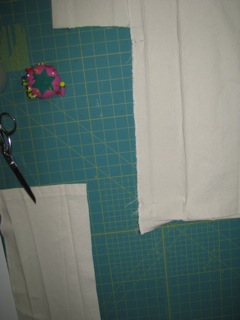
You can also see that i've undone the hem for a couple inches before the seam. there's no need to have the hem in the seam, so we'll trim it out before I redo the hem.
I sewed a seam from the hem to the fell (which will be the bottom of my pocket opening), with a 1/4 seam allowance. Press that flat, turn the fabric right sides together, and sew another 1/4 seam, and you end up with this:
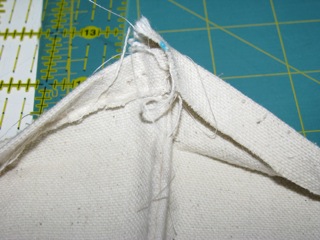
here's the pattern I used for the pocket bags:
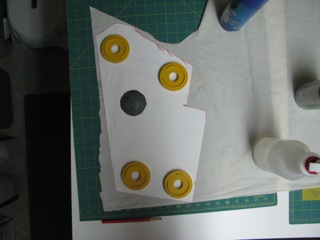
the two inch extension on the lower right of the piece is what's used to attach it to the flap. I've got the entrance to the pocket at the bottom of the pleat. That means that the side of the pocket that's closest to the wearer's body is shifted an inch (in my case; in general, it's the difference between the pleat depth, and the pleat reveal) towards the center, compared to the part that's farther away. Since i used the same pattern to make both halves of the bag, the seam at the far opening isn't on edge of the pocket. I put it back there by putting in a pleat at the top of the bag, when it's sewn to the top of the kilt. Here's the bag sewn shut; again it's a french seam, this time with a 1/8" seam (well 3 mm, since that's what I've got marked on my Swedish sewing machine).
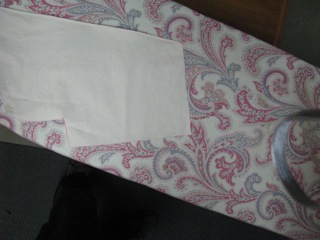
This is the inside of the kilt. The part to the right (which is the overapron side) has the pleats sewn down; the side to the left only has the first two or four done.
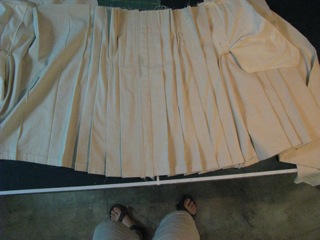
-
-
21st July 09, 10:25 PM
#16
I was thinking that a French seam was the same as an Hongkong finnish, but it sounds a little different...
* Oh wait, I understand what you did there. I just got the terms mixed up.  Never mind. Never mind.  * *
Last edited by Bugbear; 22nd July 09 at 01:23 AM.
I tried to ask my inner curmudgeon before posting, but he sprayed me with the garden hose…
Yes, I have squirrels in my brain…
-
-
22nd July 09, 01:11 AM
#17
 Originally Posted by herminator

Please, for me german:
What is duck cloth?
Panamaleinwand.
Vin gardu pro la sciuroj!
-
-
22nd July 09, 04:57 AM
#18
 Originally Posted by Ted Crocker

I was thinking that a French seam was the same as an Hongkong finnish, but it sounds a little different...
* Oh wait, I understand what you did there. I just got the terms mixed up.  Never mind.  *
Huh, and I was just about to explain how to do a french seam... Well, now I won't, so there. (insert smiley conveying ironic sulk)
Btw, I'm surprised a french seam worked well (as it appears to have done) with duck cloth, it's generally considered a bad idea when working with heavy fabrics. But apparently it works if you press the living daylight out of it! 
Vin gardu pro la sciuroj!
-
-
22nd July 09, 07:50 AM
#19
 Originally Posted by Heming

Huh, and I was just about to explain how to do a french seam... Well, now I won't, so there. (insert smiley conveying ironic sulk)
My confusion with the seam was because I kept thinking that all the pleats had to make it differnet. It doesn't, it just adds some confusion, and the hassle of having to deal with twenty feet of fabric.
For those playing along at home, a french seam is one that has two seams close together, with the first seam folded inside the second, hiding the raw edges inside the seam. To make one, you put the fabric wrong side together (which is backwards from normal), sew a seam, then fold the fabric right sides together, and sew another seam. It's a finish not much seen on ready-to-wear clothes these days, as it's easier and cheaper to finish the raw edges with an overlock machine (serger, in home sewing speak). I don't have one, so the french seam. One disadvantage of the french seam is that if you get the seam allowances wrong, the raw edge of the fabric is on the right side of fabric. There's a variant, called the french drapery seam, which uses a slightly different technique (one of the edges is cut longer than the other, and folded to make sure there are not threads poking through to the right side. That's harder, and there's another layer of fabric adding bulk to the seam.
A Hong Kong finish, mentioned by Ted above, is another way of finishing raw edges. It has a piece of fabric tape that encloses the raw edges. It's very often a contrasting fabric, designed to attract attention to it.
Btw, I'm surprised a french seam worked well (as it appears to have done) with duck cloth, it's generally considered a bad idea when working with heavy fabrics. But apparently it works if you press the living daylight out of it! 
The problem with french seams in heavy fabric is that it adds a lot of bulk. But french seams are used on canvas tote bags and the like: a french seam has two independent sets of threads holding the seam together, so if the first fails, the seam doesn't.
On the kilt, there's a lump, but it's at the edge of pleat, so I don't think it'll be a problem. If I had an overlock, I'd use it. I considered using a tape finish (I've got some superlight weight net stuff that works well), but I decided against that. (My hope in posting these is that other people copy them, so using strange notions complicates things, and might discourage someone.)
-
-
22nd July 09, 10:08 AM
#20
Ya, I thought you were taking a strip of the fabric and sewing it over the raw edges, kind of like done with bias tape, when I first read the post. But that was because I had the terms mixed up. 
This has been a neat thread to follow.
I tried to ask my inner curmudgeon before posting, but he sprayed me with the garden hose…
Yes, I have squirrels in my brain…
-
Tags for this Thread
 Posting Permissions
Posting Permissions
- You may not post new threads
- You may not post replies
- You may not post attachments
- You may not edit your posts
-
Forum Rules
|
|























Bookmarks